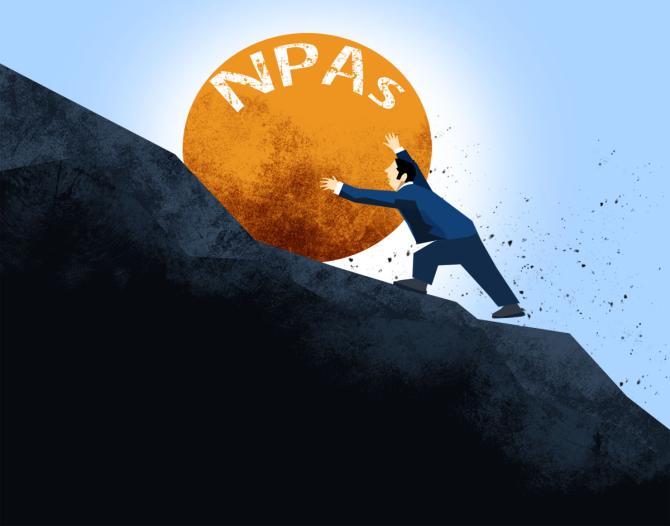The target was for banks to sell Rs 2 trillion worth of non-performing assets to NARCL, the so-called 'bad bank', by 2021-2022.
Only 10 per cent of this has been executed.

Karnam Sanker, the chairman of the National Asset Reconstruction Company Ltd (NARCL), has quit.
Going by reports, his exit has something to do with a proposal to merge NARCL with its 'twin', the India Debt Resolution Company Ltd (IDRCL).
NARCL, the so-called 'bad bank', was set up in July 2021 to buy legacy stressed loans from banks.
It is an asset reconstruction company (ARC) that would buy the bad loans at a mutually agreed value and work to recover the debts or associated securities.
IDRCL is an asset management company meant to work in tandem with NARCL to help clean up bad assets.
It would be innovative to merge the two. The combined entity would consolidate and take over stressed debt from banks and manage and sell them to alternate investment funds and other potential investors.
The target was for banks to sell Rs 2 trillion worth of non-performing assets (NPAs) to NARCL by 2021-2022. Only 10 per cent of this has been executed.
The NARCL-IDRCL model, unlike private ARCs registered with the Reserve Bank of India, was backed by government funding.
The Report of the Committee to Review the Working of ARCs (2021) has pointed out that of the 28 ARCs (private) in operation, the top five accounted for 70 per cent of the total assets under management as of 2020-21.
Only three ARCs had net-owned funds above Rs 1,500 crore (Rs 15 billion). In terms of the capital base of the sector, more than 54 per cent is held by the top three ARCs.
ARCs have been in operation since 2003, but their management of stressed assets is still uneven.
Data for the financial years between 2002-2003 and 2012-2013 shows banks and other investors could recover only 14.29 per cent of the amount owed by borrowers in respect of stressed assets sold to ARCs.
About 80 per cent of the recoveries by ARCs has come through deployment of measures of reconstruction that do not necessarily lead to revival of businesses.
This pales in comparison to Securum of Sweden, which, during 1992-1997, recovered close to 86 per cent of the stressed amounts involved.
Danaharta of Malaysia squared 58 per cent of the stressed amounts (1998-2005).
Globally, there have also been public-private partnerships: Spain created the 55:45 Sareb in 2012, and Ireland the 51:49 National Asset Management Agency in 2009.
Given that recapitalisation of State-run banks could not go on forever due to financial constraints, it was felt that the NARCL-IDRCL model was the best bet, especially for large dud-credits. So, what happened along the way?
"Though NARCL did start with a focus on Mint Road's List-1 and 2 on bad loans (this was circulated among banks), the situation has changed a lot since. The prospects for bad assets resolution have faded due to their eroded values," says a senior banker, speaking on the condition of anonymity.
A senior official with a private sector ARC says there are few corporate bad loans still on the books of banks that have any value left.
Thus, the stock of transferable NPAs is small. Second, most of these NPAs are more than three or four years old and carry over 90 per cent provisions, in line with regulatory norms.
There is little or no incentive for banks to offload these loans to ARCs.
Over a period, lenders would opt to write them off their books while retaining the right for recovering dues from borrowers through legal process.
Third, banks have already filed cases under the Insolvency and Bankruptcy framework for resolution.
This may take a long time, but banks are fine by it as it is a court-approved process.
Last, there has been a change in priorities over a period in pricing preferences.
Now, lenders want cash up front and have very little interest in getting part of the money in the form of security receipts (SRs) of 85 per cent.
This has reduced the advantage of government guarantees for SRs that NARCL makes for bad loans.
Now the elephant in the room. The entire matter is within the State Bank of India group's domain, as key executives and directors in NARCL and IDRCL are drawn from the country's largest lender.
That brings us to what RBI Deputy Governor M Rajeswar Rao said on April 30, 2022: 'What is the average time taken between default by a borrower and the eventual filing of application for insolvency resolution by creditors?'
The point is, if you are late in identifying the problem, you will be left with what is worthless.
Rao was not speaking on ARCs, but an adjacent issue: Resolution of Stressed Assets and IBC (Insolvency and Bankruptcy Code).
'It would also be interesting to see the relationship between such filing delays and the value deterioration that the creditors are required to recognise subsequently,' he had said.
There is another side to bad banks.
'Bad banks, essentially formed to ease the burden off banks' balance sheets, may encourage further build-up of risky assets. Knowing that they have the bad bank option to fall back on, banks may become less vigilant in giving out loans, leading to the problem of moral hazard,' said a paper by Snehal S Herwadkar, Arpita Agarwal and Sambhavi Dhingra from the Banking Research Division of the RBI's Department of Economic and Policy Research in its monthly bulletin of February 2022.
That brings us running to the same spot.
Feature Presentation: Rajesh Alva/Rediff.com










